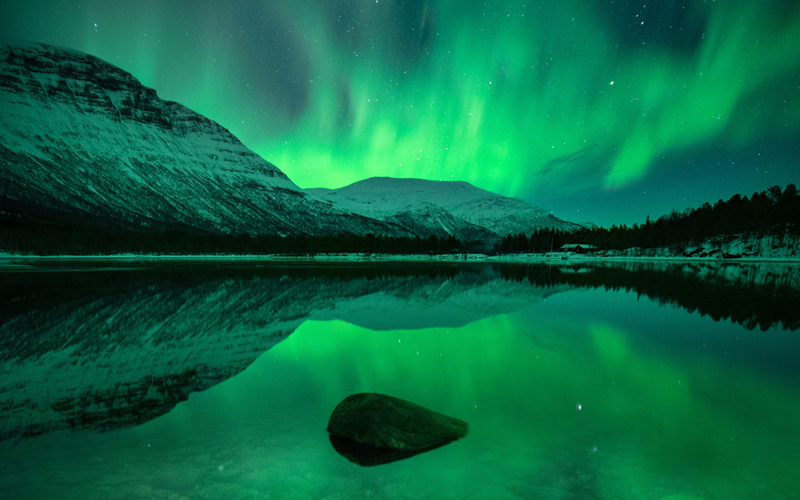What is the Aurora Borealis and Aurora Australis?
The Northern & Southern Lights are the result of collisions between gaseous particles in the Earth’s atmosphere which come from the Sun. Those particles are charged and released from the sun’s atmosphere. Variations in colour are due to the type of gas particles that are colliding with. You’ll learn more about this in depth on your Aurora Hunt.

When is it the best time to see the Northern Lights?
The Aurora Borealis season is between mid-September and mid-April each year. This is because we need darkness in order to see the activity. The best time to come is with what works with your plans already. There is some data suggesting that there is increased activity during Autumn and Spring. However, we frequently see Northern Lights in Tromsø region throughout the season. The factor that affects the probability of seeing Northern Lights is finding ample gaps in the clouds. Even with high predictions of activity, if there is increased cloud coverage, it is not as likely to see the Nothern Lights.
The solar cycles, which are responsible for the light, go up and down all the time. Right now we are in the beginning of an upwards cycle with “more activity”. That being said even on a year with less activity we were seeing Auroras almost every night. When we don’t see any activity, it is mostly due to heavy cloud coverage. Due to where Tromsø is located we have the most sightings of Aurora world-wide, even on ‘low’ years we still see them very frequently.
When is the best time to come?
If you are wishing to make the most of your Arctic holiday and are looking to pair your Northern Lights activity with other winter activities, we’d suggest coming when there is likely to be snow. Between January and April each year you can enjoy Husky Sledding, Snowshoeing, Reindeer Sledding as in all probability there will be ample snow fall. Some years the season for these activities is opened early, however, there is no way to know in advance.
Why Tromsø is the best place to see the Northern Lights
Tromsø is the only city in the world to be in the heart of the Aurora Oval. The city is located along the gulf stream, having a network of microclimates which makes it an Aurora sweet spot. For these reasons, no other city compares to Tromsø if your goal is to see the Northern Lights.
Tromsø is in the heart of the Aurora Oval. The Aurora Oval is an oval shaped belt that runs around the earth at both the top and the bottom. The belt is the areas that can see activity depending on the KP. As Tromsø remains in the heart of the belt, it is possible to see the Northern Lights even at a KP 1 or less.
Tromsø is 70 degrees north. This means that Tromsø is situated in the Aurora sweet spot; the nights are dark enough to see activity consistently from September until mid-April. The city is far enough north that activity is visible even on a kp 1.
Regarding the kp, don’t worry too much about this. If there is any solar activity in the Northern hemisphere, then we would see it here, assuming there are gaps in the clouds, and it is dark. This is because Tromsø is located at 70 degrees north.
Tromsø is in a region with an exceptional number of microclimates. Each valley, fjord, mountain and plateau can have significantly different conditions to the neighbouring region. That means that even on very cloudy evenings it is possible to clear skies within a 2 – 3 hr drive. The environmental conditions here are very dynamic. They can change so fast that it is impossible to predict the cloud coverage pattern even within a few days.
The reason the forecasts and apps are so unreliable here is because we have so many deep valleys, fjords, inland plateau and the gulf stream. The forecasts and apps do not account for these other regions, nor is checking the conditions in Tromsø representative of the other regions.
The number 1 reason Tromsø is the best place to come on vacation is because…
…Tromsø is in the gulf stream. This island surrounded by ocean water that has travelled across the Atlantic and up the Norwegian coast. This beautiful ‘warm’ water is straight from the Caribbean, keeping Tromsø surprisingly warm even throughout winter. In the heart of winter that temperatures in the city will likely go between 1 and –6 with exceptionally cold days reaching –10 or colder (so brace yourself, Winter is coming). The coldest day on record was a brisk –18 degrees. As most travellers stay in Tromsø city, this means that the majority of their stay is comfortable and suitable for the whole family.
However, don’t be fooled, just one hour inland into one of the deep valleys and away from the gulf stream, it is often a fresh –20 to –30 degrees. As tour companies often go inland on evening Aurora Hunts, most have age restrictions in order to protect those vulnerable to such temperatures and too small to regulate their body temperatures properly.
Want to see more?
Please check out our Instagram page for recent photos and below. Here are the links to our extended gallery. This is for our Aurora Hunt. You can have a look at how different the Aurora can look depending on the environmental conditions at the time of taking the photo.
For any additional questions, please have a look at our extended FAQ database. If you want to learn about the challenges in finding the Northern Lights than you’ll love this post How hard is it really to find the Aurora Borealis?

